Adam Maurer, VK4CP
Issue 66, August 2000

Willis Island, off the coast of Queensland,
Australia
Where?
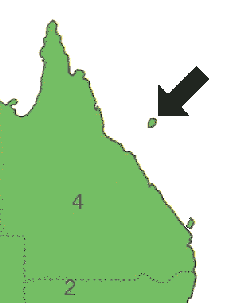 Willis
Island is an external territory of Australia, located beyond the Great Barrier
Reef in the Coral Sea some 420km east of Cairns, Queensland It lies in CQ Zone
30, the grid square is QH43 and it’s IOTA OC-007.
Willis
Island is an external territory of Australia, located beyond the Great Barrier
Reef in the Coral Sea some 420km east of Cairns, Queensland It lies in CQ Zone
30, the grid square is QH43 and it’s IOTA OC-007.
The Australian Bureau of Meteorology has a Weather Monitoring station on the island and apart from the three Met Buro staff at any one time Willis is home to a plethora of wildlife, predominantly thousands of Booby birds. These birds were nesting at the time and extreme care was needed to avoid stepping on any eggs whilst walking along the track to and from the beach.
The Boobies have an amusing if not strange tactic of pretending to be injured. They will run along in front of you flapping a pretend broken wing and not flying out of your way(?).
The VK9WI team
The team consisted of; David Gemmell VK4ZEK (Skipper), David "Harry" Holton VK4DH, Alan Meek VK4BKM (CW op), Nick Hacko VK2ICV (low bands op) and Peter Garden VK4APG (six metre op, cook and QSL Manager). The pilots were Bill Rothwell GØVDE (EU) and Adam Maurer VK4CP (rest of World).
Getting there
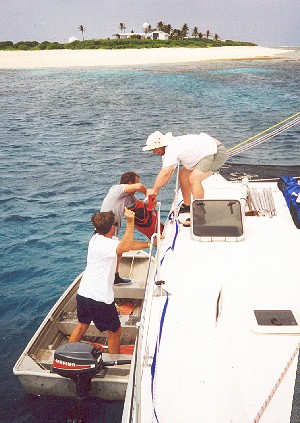 Unloading
gear from the cat moored 200m out from the shore.
Unloading
gear from the cat moored 200m out from the shore.
The journey to and from Willis was made in the 43ft sailing catamaran, "Bach & Byte" and the timing of the DXpedition was determined by the ocean racing commitments of the cat. Simply, without David’s catamaran there would not have been a DXpedition! The major ocean race in southern Queensland is held at Easter, and a late Easter this year meant a late VK9WI. Despite the DXpedition to Willis taking place rather late in the period around equinox, the six-metre results were still quite reasonable. The 1500kg of gear was loaded on board at Yeppoon where the cat departed from on Tuesday May 9th. The trip out was uneventful though we did spend one day sheltering behind an island due to strong winds and high seas. Once we had passed through the Great Barrier Reef it was smooth fast sailing all the way to Willis. The Bach and Byte is very fast and speeds of up to 17 knots were reached with the spinnaker up. The memorable moment came early Friday morning around 3am when we were joined by a group of dolphins riding alongside our bows. Four days after leaving Yeppoon we had arrived around 1am on Saturday (May 13th) at which time the crew took a well deserved nap.
Land ho!
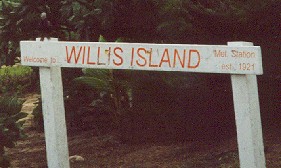 Welcome to Willis!
Welcome to Willis!
7am Saturday morning and in action again with the arduous task of unloading all the equipment lot by lot into the dinghy and transferring it to shore. Use of a wheelbarrow from there made it easier to get the gear into the operating shed.
There is no sheltered anchorage at Willis and given the constant 20+ knot south-easter there is always a small surf running even on the lee side of the island. As it turned out, the anchor cable and terminal gear were tested to breaking point in the constant surge and a second anchor had to be deployed. Harry was largely confined to the boat as he was nursing a rather nasty gash to the leg from an earlier mishap aboard the cat. Harry’s constant attendance on the cat proved essential so as not to let the only means of return travel float away in the distance!
Equipment included two HF stations with linears, a six-metre station and an AO-10 station. One HF station would concentrate on 160/80/40 during local nighttime with a Battlecreek special antenna. The second HF station would always concentrate on 20/15/10 with a tri-bander yagi. Even though tents were packed we were lucky enough to setup shack in one of the Met Buro sheds. Use of the mains supply was already pre-arranged. The six-metre station consisted of a barefoot TS-60 and a five-element K6STI design yagi at 22 ft (the same yagi as used by H44PT in April). A 20W beacon on 50.051MHz was installed on the boat about 600 metres from the shack, but we found that it splattered across 110 too much so it was switched off. Plans to use a programmable keyer to put the TS60 into beacon mode as an alternative did not eventuate as the planner made an unexpected early departure from the scene!
Band Conditions?
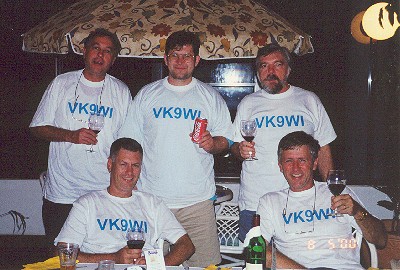 Sitting
(from left) VK4BKM, VK4ZEK. Standing (from left) VK4DH, VK2ICV, VK4APG.
Sitting
(from left) VK4BKM, VK4ZEK. Standing (from left) VK4DH, VK2ICV, VK4APG.
Sunday May 7th, just seven days before VK9WI was expected to be on the air, gave us strong Es between VK4, YJ8 and FK, an area in which Willis is virtually in the middle of! Although rather early for the VK winter Es season it seemed promising that we might be able to work back home on Es. F2 contacts into California and Nevada were also made on May 7th, so despite being well after the equinox period there was still a slim chance that VK9WI might actually work across the Pacific. Before departure we had checked VK4FNQ’s daily six-metre loggings from northern VK4, as a guide to what to expect: Japan, South East Asia, the Pacific and maybe North America were all possible.
Sunday May 14th at 0304 and the first six-metre QSO with YF1OO. Eighteen minutes later and VK4’s were being worked. Working the 1300km back to our home grid on Es not long after the six-metre rig was first switched on was a real thrill and most unexpected. It was a delight that VK9WI made the grade to continental USA by working Bob, K6QXY, and our contact with Jack, N6XQ, was country #99 for him.
VK9WI had a strong presence on HF into most of Europe. Reports indicated that we were putting a very good signal into all target areas on HF including EU on 14/18/21/24 & 28MHz during UK daytime. Also, good reports were being received for the low bands at the appropriate times. All seemed to be going well.
Oops!
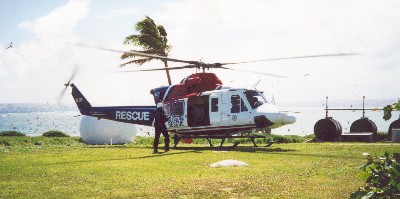 The rescue
helicopter
The rescue
helicopter
Monday evening, only the third day on the Island, and a sudden QRT. The hours stretched – questions were asked on the clusters – where were the guys? VK9WI was nowhere to be heard. "Houston – we have a problem". The following morning came the bad news that there had been an accident. Peter (the main six-metre op) had an unintentional encounter with the aluminium dinghy which broke his lower left leg in three places. He was ferrying the makings for a BBQ from the cat’s galley ashore when a wave dumped the dinghy on his foot just as he was stepping ashore. Aghh!!! Umm, guys can we please use the satellite phone to make an emergency call?
Luckily, Willis Island is just inside the range of the State Emergency Services’ rescue helicopter based in Cairns. The six-metre and WARC yagis were torn down and put to one side in order to make a landing space for the chopper. The flight out from Cairns almost exhausted the fuel supply and the chopper was re-fuelled with diesel from the Met Station generator supply (didn’t know they could run on diesel!) The patient was flown the 426km to Cairns Base Hospital. Doctors agreed that the helicopter was by far the best option, as the crew had discussed packing up all the gear and sailing away on day four with maybe a three to five day trip back to the mainland.
This left the three remaining members spread pretty thinly over the ground. Whilst lying in his hospital bed Peter was expecting 50MHz to be neglected, but Alan kept the six-metre QSOs going. Unfortunately OSCAR operations had to be cancelled as there simply wasn’t enough manpower left other than to keep plugging away on the heavily populated mainstream bands. The highest priority was to work HF and six metres and to try and give as many operators a new one on at least one band.
The life of a DXpedition pilot
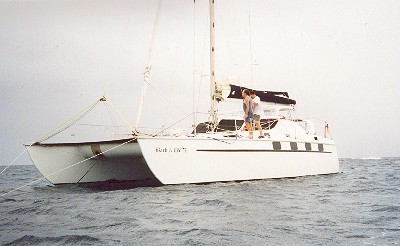 The catamaran that took us to Willis
The catamaran that took us to Willis
Well, this was a first for me. Just what does a "pilot" do? Bill was in the same situation and obtained some prior advice and suggestions from the FO0AA and TX0DX pilots. Bill got involved in late February by finding the VK9WI web site and reading the ‘operating procedures’. He e-mailed David to say – what a good idea if all DXpeditions stuck to this – and quick as a flash, David e-mailed back to say –"EU pilot job vacant – how about it?" and Bill got stuck with it!
Bill was to look after Europe and I would look after the rest of the world – disappointingly there weren’t any volunteers from North America to look after that side of the pond. I had a sked every morning with the team, initially on 40m then onto 20m once they were further out. After the exchange of traffic and any necessary phone calls I cobbled together a news release which I would FTP up to the VK9WI site, post to the VK9WI eGroup mailing list and send to Bill who would distribute it on the appropriate newsgroups and other outlets including packet.
Watching the packet and Internet clusters – replying to announcements and questions were all part of the daily job. Sounds simple but between them they consumed at least six hours each day! Contact between Bill and me was via e-mail, as was getting the log data (eventually) back to the mainland. Originally, log information was to be sent back via an HF AMTOR link but the MFJ-1278 TNC that I had a loan of just didn’t want to play!
Thankfully the team had access to the Internet from the Met Buro office but this was used sparingly so as not to outstay their welcome. The pilots received many individual requests... can you please listen for ABC on XX band at YY time. Hmmm. OK, lets try running all the individual requests through a low pass filter and see what we end up with! Trying to balance all the conflicting demands with only three operators was going to be an impossible chore. Still, given the limited resources I think we managed to satisfy most… unfortunately except the AO-10 folks. The biggest lesson learnt is that you’ll never be able to please everybody all the time.
Final Days
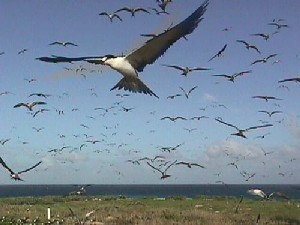 Some the numerous seabirds on the island
Some the numerous seabirds on the island
In order to leave the island safely we had to depart on a high tide so as to clear the reefs. This meant packing up most of the gear on Sunday May 21 and leaving one HF station running into the early hours of Monday morning. This gave Nick one last shot at 160 (a band just as frustrating as Six). All the gear was then carried back down to the beach, loaded into the dinghy and then transferred back onto the cat. On the Monday morning we only had to dismantle the Battle Creek Special and a tri-bander, so not too much of a hard job. Alan donned his scuba gear to have a last look at the tropical fish and pick up the second anchor and then we were off. The trip home was very rough with 40 knot winds and four-metre seas all the way to the coast. It was a very tired (and relieved!) crew that made it back to terra firma (Bowen) at 5am on the Wednesday morning.
Results
Considering the less-than-ideal timing, short lead-up time, lack of man-power, and the fact this was the first DXpedition for most of the team, the 1500+ six-metre QSOs were quite an achievement. Remembering this wasn’t some huge multi-national DXpedition team with a dozen operators or so, the 18,600 QSOs on all bands from 160m to 6m in eight days was a pretty good result. Alan, Nick, David and Harry did a great job under trying circumstances, and the lessons gained will be invaluable for ‘the next one’.
50MHz statistics
The table indicates the first QSOs made with each of the 15 countries worked.
|
DXCC |
QSOs |
First |
Date |
UTC |
|
|
Indonesia |
4 |
YF100 |
14/05/2000 |
03:04 |
|
|
Australia |
17 |
VK4KK |
14/05/2000 |
03:22 |
|
|
Vanuatu |
1 |
YJ8UU |
14/05/2000 |
04:17 |
|
|
South Korea |
8 |
HL3IUA |
14/05/2000 |
08:30 |
|
|
Japan |
1508 |
JH7MQU |
14/05/2000 |
08:31 |
|
|
Hawaii |
6 |
KH6SX |
14/05/2000 |
23:41 |
|
|
Marshall Is. |
2 |
V73AT |
14/05/2000 |
23:41 |
|
|
Philippines |
1 |
DU1EV |
15/05/2000 |
11:35 |
|
|
Taiwan |
3 |
BV2DP |
15/05/2000 |
11:38 |
|
|
USA |
11 |
K6QXY |
15/05/2000 |
00:31 |
|
|
Hong Kong |
27 |
VR2LC |
18/05/2000 |
13:12 |
|
|
China |
2 |
BG7OH |
18/05/2000 |
13:29 |
|
|
Singapore |
1 |
9V1UV |
20/05/2000 |
03:27 |
|
|
Guam |
1 |
KH2JU |
20/05/2000 |
11:45 |
|
|
Mariana Is |
1 |
N3WW/KHØ |
20/05/2000 |
21:38 |
VK9WI has a web site with more information and pictures for you to check out:
http://www.qsl.net/vk9wi. The complete six-metre log and statistics can be found at http://www.ozemail.com.au/~vk3alm
Thanks go to the Met Buro guys for allowing us to use not only the mains power, the equipment shed for the shack but also the Internet connection. Oh, and the use of that satellite phone. There are also many sponsors and donors the team would like to thank, without their support DXpeditions such as this could not happen. Please check out the list on the web site and support those who support these trips that help give us a new one!
Postscript
No one was more pleased than Peter to hear that, during the very rough trip home from Willis Island, a welded fitting on the aluminium dinghy broke causing it to be abandoned at sea - a "hazard to navigation" and no longer a hazard to legs!
Peter: the upside of having a broken leg is - no distractions from doing the QSLing!
* This article is the result of contributions by Peter Garden VK4APG, Alan Meek VK4BKM and Bill Rothwell GØVDE.